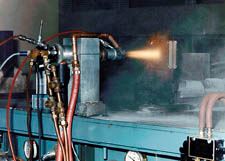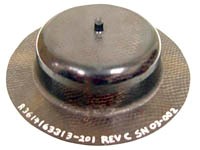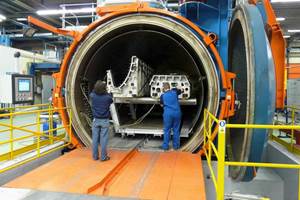Are high-temp thermosets ready to go commercial?
Developed for the U.S. military, these high-performance matrices are branching out into wider use.
While reinforced ceramic and metal matrix composites have the ability to take extreme heat -- 1649°C/3000°F or more -- many designers prefer polymer resins to ceramics or metals because polymers perform better under fatigue than more brittle ceramics and are much lighter than most metals. Thanks to a long series of military and aerospace research projects, an array of thermoset resins have been developed to handle moderate-to-high temperatures and tough conditions with ease -- providing weight savings and lower life-cycle costs into the bargain. While most of these materials have been around for decades, some new variations and end-uses are emerging for situations where no other materials can do the job. And the advent of new nanocomposites promise some improvements, as well.
"All of these materials have their place," says NASA's John Connell, a high-temperature polymer expert and a member of the steering committee for the "High Temple" workshop symposium sponsored each year in the U.S. by NASA and the U.S. Air Force Research Laboratory (AFRL) for high-temperature resins. "It's a matter of finding the best combination of processing and performance characteristics for the end-use," he says, adding, "Of course, cost of the final component is a major consideration."
The formidable range of available polymers includes several types of polyimides; cyanate esters, bismaleimides, benzoxazines, phthalonitriles and phenolics, as well as new nanocomposite-enhanced resins. HPC takes a brief look at some of the history, chemistry, issues and end uses of these high-performance materials.
Polyimides
"Traditional linear polyimides have a high melt viscosity that limits processability and, consequently, end-use," explains Connell. "By lowering the molecular weight and using reactive endcapping agents to produce thermosetting polyimides, the processability has been improved."
Thermosetting polyimides, originally developed in the 1970s at NASA Lewis for military aircraft engines and airframes, are produced by dissolving an aromatic diamine, a dialkyl ester of tetraxarboxylic acid and a monofunctional nadic ester endcapping agent in a solvent, such as alcohol. The resulting solution is typically used to produce prepreg. PMR-15 is the best known of these thermosetting formulations -- PMR is shorthand for in-situ polymerization of monomer reactants -- and it is "very successful" in producing good thermal and mechanical properties, says Dr. Ruth Pater, a senior polymer scientist at NASA's Langley Research Center.
But, while PMR-15 and similar variants have good mechanical properties, they contain the hazardous compound methylenedianiline (MDA), creating a potential health and safety issue. NASA encouraged research to develop new versions, using less-toxic monomers, and several have emerged. Pater was directly involved in the development of RP-46, patented in 1991, a direct PMR-15 replacement with very similar chemistry. Unitech Corp. (Wake Forest, N.C., U.S.A.) is one of two licensees of the RP-46 resin technology.
Because of its high degree of crosslinking, a carbon fiber/RP-46 composite has a glass transition temperature (Tg) of 397°C/747°F and sustained service temperature is 357°C/675°F. Unitech chemist Perlita Razon says tests show that short-duration spikes to 815°C/1500°F can occur without resin breakdown. RP-46's thermoxidative stability is very high, meaning it resists oxidation (combustion) that breaks down molecular bonds and causes weight loss and structural decline, even at very high temperature. Flexural strength is 71 ksi at 343°C/650°F under hot/wet conditions. Their high crosslink densities also make polyimides fairly brittle, and microcracking under repeated heat cycles can occur, although in many applications, it isn't an issue.
RP-46, like PMR-15, cures with a condensation reaction, meaning that water and alcohol are evolved and given off from the polymer chain during cure. NASA's Connell says that the volatiles can be dealt with by designing the cure cycle with specific ramp-ups and holds at different temperatures, to ensure the volatiles are driven out of the part to eliminate voids. AFRL's Dr. Katie Thorp adds that the cure has to be designed so that the moisture evolution occurs before the crosslinking step, for best results.
In addition, a downside to older-style polyimides is their tendency to absorb moisture after cure. According to Connell, the newer polyimides have licked that problem to a large degree, with most absorbing less than one percent. Unitech cites data of 0.62 percent weight gain due to moisture absorption for a unidirectional carbon/RP-46 composite after 30 days at 85°C/185°F and 85 percent relative humidity.
The PMR chemistry with solvents and volatile evolution means that most processing to date has been limited to prepreg-based methods, although lower-viscosity versions are available, which are more suited to dry reinforcements and closed molding processes. Razon says Unitech is working on a new version of its resin that can be used in lower cost infusion processes. Another processing concern is that reaction time is fairly short and high cure temperature and pressure -- 325°C/617°F and 200 psi -- are needed, which may necessitate specialized autoclave or press equipment for some manufacturers.
YLA Advanced Composite Materials (Benicia, Calif., U.S.A.) does 90 percent of Unitech's prepregging, for customers that want prepregs for their applications. Several proprietary products are being produced with RP-46, including a high-temperature bearing for a commercial aircraft engine and a radome application. "RP-46 has excellent dielectric properties," states Razon, which was a major reason for its selection by the radome manufacturer. Quartz fiber/RP-46 woven prepreg cloth is hand layed up on composite tooling and the parts are autoclave-cured. Razon says that, at the speed the part travels, it sees 371°C/700°F temperatures for three to four minutes and spikes of 538°C/1000°F for approximately 30 seconds at a time, all easily within the part's performance specifications.
More polyimides and variants
An example of a successfully commercialized PMR- type polyimide is Goodrich Corp.'s (Stow, Ohio, U.S.A) SuperImide polyimide. The resin system, with chemistry based on high levels of aromaticity, was developed in the early 1990s by Goodrich as a "family" of resins with tailorable performance characteristics. Commercialization occurred in 2000 and since that time, over 1 million fabricated components have been produced for aircraft brake and jet engine applications. Several versions of SuperImide are currently available. Goodrich does not offer the raw material commercially, but is an exclusive supplier of finished, engineered components, per customer design requirements.
SuperImide resin-based components provide high levels of thermoxidative stability, withstanding continuous operating temperatures in excess of 343IntC/650IntF. For applications where thermal spikes are encountered, Goodrich maintains that SuperImide components can readily withstand repetitive thermal spike temperatures greater than 537IntC/1000IntF.
Other second-generation, non-MDA containing polyimides include those commercialized by Maverick Corp. (Blue Ash, Ohio, U.S.A.). (Maverick also sells traditional, military-qualified but MDA-containing MVK-19, PMRII-50 and AFR700 polyimides.) The Maverick resin was developed through a small business innovation research (SBIR) grant, in conjunction with NASA Glenn Research Center, with lower cost infusion molding in mind, according to the company. Using solvent-assisted resin transfer molding (RTM), complexly shaped parts, like aircraft engine cooling tubes with use temperatures of 260°C/500°F, can be produced with braided reinforcement. Cured parts exhibit Tgs up to 335°C/635°F and good thermoxidative stability in aircraft engine environments.
For NASA's Connell, the focus has been on a different polyimide chemistry, termed phenylethynyl (PE), or sometimes referred to as PETI, for phenylethynyl terminated imide, a reference to the polymer chain's phenylethynyl "end caps." PETI resins came about because of the desire for a structural matrix resin that could provide higher temperature performance and longer-term thermoxidative stability than bismaleimides. Work was originally conducted under NASA's High Speed Civil Transport (HSCT) program and continued with Air Force, NASA and jet aircraft engine manufacturer funding, with high-temperature engine parts in mind, says Connell.
"We believe that developing an RTM-able form of a very high-temperature resin is a real breakthrough," he adds. Since the resin cures in an addition reaction without volatile evolution, void- and microcrack-free carbon/PETI demonstration parts have been produced with Tgs as high as 375°C/707°F, using a material identified as PETI-375. Another version, designated PETI-330, is being commercialized by UBE America (New York, N.Y., U.S.A.), with a Tg of 330°C/630°F and continuous use temperatures (>1000 hours) of 288°C/ 550°F. M & P Technologies Inc. (Marietta, Ga., U.S.A.) has used PETI-330 to produce complex parts with RTM, and flat laminates have been made with vacuum-assisted RTM (VARTM).
PETI-330 has been produced in 100 kg lots and is commercially available from UBE America, while PETI-375 is still in development. While these resins, designed for primary structural applications in airframes and jet engines, produce tough composites, they do cost more than PMR-type materials. Producing larger batches and addressing raw material costs will help, says Connell. UBE America spokesperson Stewart Bain adds, "These resins offer manufacturers an alternative, for one-step processing rather than multistep cure cycles. We're pleased with the test results so far and several customers are incorporating PETI resins into their products successfully."
BMIs and cyanate esters
BMIs are technically a type of polyimide, prepared from the reaction of maleic anhydride and a diamine. BMIs bridge the temperature performance gap between epoxies and the PMR polyimides described above. They exhibit epoxy-like processing characteristics, curing by an addition, rather than a condensation, reaction. Thus, they avoid the off-gassing characteristic of polyimides and have temperature performance intermediate between epoxy and polyimide, says Marcia Tucker product manager for BMIs at Hexcel (Casa Grande, Ariz., U.S.A.).
Brittleness also is an issue with traditional BMIs used in airframes, and resin suppliers are working to address this with thermoplastic or elastomeric fillers. Newer BMI versions have greatly improved toughness that meets or exceeds that of polyimides.
Hexcel's F655 resin is one BMI product that sacrifices a bit of temperature performance for enhanced toughness. F655's Tg in dry conditions is 288°C/550°F, and it exhibits excellent compression strength after impact. In addition to standard autoclave processing, Hexcel's BMI also can be processed via RTM methods. F655 resin is being used by The Nordam Group (Tulsa, Okla., U.S.A.) for the Gulfstream G-450 thrust reverser.
Cytec Engineered Materials Inc. (Tempe, Ariz., U.S.A.) is well known for its BMI resin products used in aerospace, as well as its extensive overall high-temperature materials portfolio. CYCOM-5250-4 is Cytec's best-known BMI product, which can be prepregged or used as an RTM resin. The resin has a dry Tg of 296°C/565°F, and RTM'd parts exhibit continuous service temperature resistance up to 204°C/400°F, with excellent toughness. Cytec's BMI resins have been used for years in F-22 fighter jet parts.
An industry source says that, in addition to its existing polyimide products, Cytec will soon begin offering a new high-performance polyimide resin originally developed by the Air Force. With no MDA, AFR-PE-4 has performance equivalent to PMR-15, with easier processing.
Cyanate esters are a high-temperature resin family traditionally associated with space applications, because of very low dielectric properties (i.e., the material is transparent to electromagnetic signals) and extremely low moisture uptake compared to other resins, particularly polyimide. William McCarvill of Commercial Chemistries LLC (Salt Lake City, Utah, U.S.A.) says cyanate ester is attractive because it combines low moisture uptake with temperature resistance sufficient to handle the extreme temperature swings in space. Any moisture absorbed during processing will outgas in space, which can affect the stability of the part, particularly if it has to measure or record sensitive data. Cyanate ester's lower moisture uptake means lower shrinkage during cure and substantially less outgassing, and it is more resistant to microcracking.
Downsides are insufficient toughness in lower cost versions, a lower temperature resistance than BMI in most cases and the need to protect the resin from moisture. According to YLA's director of marketing Sean Johnson, it is necessary to prevent exposure of the resin to water during progression of the cure reaction, through cure dwell cycles. Prudent housekeeping is recommended, he says. That includes controlling humidity, both in the resin storage area and processing area, and the use of packaging and desiccants.
Johnson points out that in bonding applications, cyanate esters are compatible with most other resin systems and can be formulated for prepreg, RTM, filament winding, towpreg, syntactic core and adhesive forms. While their cost is higher than epoxy and BMI -- as high as $125/lb (USD) -- many backbone formulations are available for tailored performance in a wide range of costs.
Cytec's cyanate ester products -- CYCOM 5245C and CYCOM 5575-2 -- are used for radome applications and in the wing of Dassault's Rafale fighter jet, says the company. Hexcel offers cyanate ester resins as well.
Phenolic still a strong performer
While phenolic resin's Tg is a relatively low 160°C/320°F, it has the benefit of a high carbon content, between 50 and 60 percent by weight, the highest of any thermoset resin. This gives phenolic its ablative property, which means that in severe heat applications, the carbon pyrolizes and forms an inert char that protects and insulates the reinforcement.
Phenolic, reinforced with stockpiled rayon-based carbon fibers, has been used for decades by ATK Aerospace Co. Inc. (Clearfield, Utah, U.S.A.) to produce the solid rocket booster motor exit cones for the Space Shuttle. The 10-ft diameter, 3m/10-ft high cones are tape-wrapped, using phenolic prepreg bias-cut fabric (cut on a 45° angle), at specific helical winding angles in relation to the rocket plume flow direction, says high-temperature resin expert Nick DeMeo of Lewcott Corp. (Millbury, Mass, U.S.A.).
Phenolic is often used as the base resin for carbon/carbon or other types of carbon matrix composites, meaning the matrix is carbonized at high temperatures in a pressurized reactor/furnace. Additional carbon is then forced into the part under high heat and pressure, by injecting hydrocarbon-containing gas or more phenolic into the reactor. The hydrocarbons are "cracked" by the high heat and pressure and solid pyrolitic carbon is infiltrated into the structure of the part, a process termed chemical vapor deposition (CVD) or chemical vapor infiltration (CVI). The resulting dense, but relatively brittle, part maintains its integrity even when subjected to rocket exhaust gases -- the high heat melts the surface of the part, but a char layer forms that insulates the underlying material from further destruction.
Other high-temp polymers
Benzoxazines, a subclass of phenolic resins, are formed by reacting a phenol with an aldehyde and an aromatic amine. While the chemistry has been known since the 1940s, Huntsman Advanced Materials (Woodland, Texas, U.S.A.) recently developed a family of benzoxazines for advanced composites and electronics applications with a Tg as high as 200°C/392°F, says Ash Chaudhari, Huntsman's regional head of the Americas Structural Composite business unit.
"These materials process like epoxies and are stable at room temperature," he says. Parts made with unidirectional carbon fiber/benzoxazine, prepared as a prepreg, have very low moisture uptake and retain high mechanical properties in hot/wet conditions. Further, they exhibit very low coefficients of thermal expansion and low dielectric, a plus for the electronic printed circuit board and small electronics market, says Chaudhari.
Like many thermoset systems, benzoxazines are fairly brittle but can be modified. Hunstman is experimenting with various fillers and filler/resin combinations to improve toughness. The company recently announced a commercial benzoxazine/epoxy hybrid resin for high-temperature RTM. The material is currently being tested for aerospace as well as wider commercial uses.
Phthalonitrile resins were originally developed by the U.S. Naval Research Laboratory (NRL) more than 20 years ago, as a high-temperature alternative to polyimide, says NRL Chemistry Division section head Dr. Teddy Keller. The group was motivated to develop a resin that would be easier to process -- without the evolved volatiles and complex cure cycles of the polyimides.
Formulated with bis-phthalonitrile monomers, phthalonitrile polymerizes in an addition-type reaction, so no volatiles are produced, says Keller. A wide variety of standard chemical additives can be used to control cure rate, making cure processing versatile and very tailorable. B-staged resin prepreg can be prepared and stored indefinitely at ambient conditions, or the resin alone can be adapted to resin transfer molding or reaction injection molding processes. At present, costs are based on research pilot plant production, says Keller, but larger production runs will help lower prices. Its ability to be used in infusion processes will help lower fabrication time and cost.
Cured carbon fiber and fiberglass/ phthalonitrile composites exhibit a Tg in excess of 450°C/842°F and thermoxidative stability approaching 371°C/ 700°F, reports Keller. The strength properties of the neat resin equal or exceed the properties of polyimides, particularly in fracture toughness and tensile strength. In terms of fire performance, phthalonitrile composites are the only organic polymeric materials able to meet the U.S. Navy's flammability standards (MIL-STD-2031) for submarine fire performance, thanks to very high char yield and low smoke and toxic-gas generation.
Eikos Inc. (Franklin, Mass., U.S.A.) has commercialized and licensed the phthalonitrile resins, which are formulated by partner JFC Technologies Inc. (Bound Brook, N.J., U.S.A.). GKN Westland Aerospace Inc. (St. Louis, Mo., U.S.A.) has used phthalonitrile resins to resin transfer mold composites reinforced with woven carbon fabric for an aircraft engine part, as a titanium replacement. The company collected extensive data on simulated operational conditions for rotorcraft, including humidity and temperature, which showed that phthalonitrile parts retained mechanical properties over a wide temperature range (-54°C to 343°C/-65°F to 650°F) and performed better than other tested resins. Electric Boat Corp. (Groton, Conn., U.S.A.) evaluated phthalonitriles for naval vessel use, and interest also has been shown for the material's use below deck on ships.
"Commercial use is also bound to occur," says Keller. "Microelectronic companies are very interested because of the material's high-temperature performance. There is also interest in phthalonitriles for downhole geothermal tooling applications."
Nanocomposites: A new frontier
The U.S. Air Force Office of Scientific Research (AFOSR) recently sponsored a project to investigate how nanofillers might improve the erosion resistance and heat transfer characteristics of solid rocket nozzle ablatives. Project researcher Joseph H. Koo of the University of Texas at Austin says that three types of nanoparticles were dispersed in a Borden Chemical resole-type phenolic: Cloisite montmorillonite (MMT) nanoclay from Southern Clay Products (Princeton, N.J., U.S.A.); vapor-grown Pyrograf III carbon nanofibers from Applied Sciences Inc. (Cedarville, Ohio, U.S.A.); and polyhedral oligomeric silsesquioxane (POSS), a hybrid silica/silicone nanoparticle from Hybrid Plastics (Hattiesburg, Miss., U.S.A.) that behaves like a ceramic filler in severe environments.
Carbon/phenolic composite samples were prepared by Cytec. Coupons were bonded to a steel substrate with an imbedded thermocouple to monitor backside heat-soaked temperature. All the nanocomposite samples, together with an industry-standard ablative material, were placed in a laboratory-scale solid rocket motor device capable of producing an exhaust plume with abrasive aluminum oxide particles, with flame temperatures up to 2200°C/ 3992°F and plume velocity of approximately 2,000 m/sec.
Results of the testing showed that all of the nanofillers improved the erosion resistance of the composite material. Carbon nanofibers at a 28 percent loading showed the lowest erosion rate of any sample. Measured heat-soaked temperatures also were lower in the nanocomposite samples, compared to the baseline ablative material. Koo says that polymer nanocomposites hold great promise for future high-temperature applications: "The greatest challenge is to select the nanoparticles that are most compatible with the polymer matrix resin, and then develop an optimal processing technique to uniformly disperse them." AFOSR is funding additional nanocomposite research at Austin and other research centers, says Koo, noting that preliminary results show a huge potential market for nanomodified materials in high-performance applications. There is also ongoing AFRL research into the use of nanofillers in polyimides for improved properties, reports AFRL's Thorp.
"We see a definite need for a reduction in the material cost and part flyaway cost for these resins," says AFRL's Thorp. "But we're very excited by the advancements that have been made, and RTM processing appears promising. More commercial use is inevitable."
Related Content
Plant tour: Spirit AeroSystems, Belfast, Northern Ireland, U.K.
Purpose-built facility employs resin transfer infusion (RTI) and assembly technology to manufacture today’s composite A220 wings, and prepares for future new programs and production ramp-ups.
Read MorePlataine unveils AI-based autoclave scheduling optimization tool
The Autoclave Scheduler is designed to increase autoclave throughput, save operational costs and energy, and contribute to sustainable composite manufacturing.
Read MoreIndustrial composite autoclaves feature advanced control, turnkey options
CAMX 2024: Designed and built with safety and durability in mind, Akarmark delivers complete curing autoclave systems for a variety of applications.
Read MoreVIDEO: One-Piece, OOA Infusion for Aerospace Composites
Tier-1 aerostructures manufacturer Spirit AeroSystems developed an out-of-autoclave (OOA), one-shot resin infusion process to reduce weight, labor and fasteners for a multi-spar aircraft torque box.
Read MoreRead Next
“Structured air” TPS safeguards composite structures
Powered by an 85% air/15% pure polyimide aerogel, Blueshift’s novel material system protects structures during transient thermal events from -200°C to beyond 2400°C for rockets, battery boxes and more.
Read MoreDeveloping bonded composite repair for ships, offshore units
Bureau Veritas and industry partners issue guidelines and pave the way for certification via StrengthBond Offshore project.
Read MoreAll-recycled, needle-punched nonwoven CFRP slashes carbon footprint of Formula 2 seat
Dallara and Tenowo collaborate to produce a race-ready Formula 2 seat using recycled carbon fiber, reducing CO2 emissions by 97.5% compared to virgin materials.
Read More

























